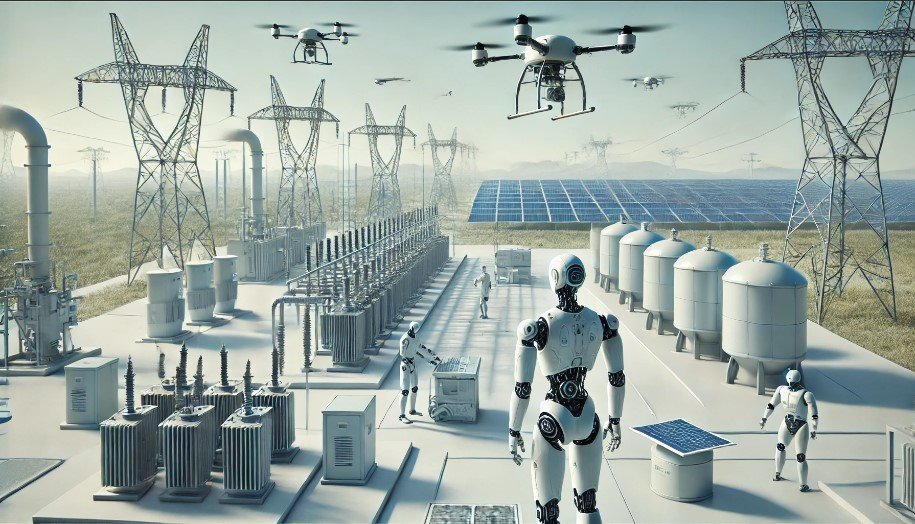We are on the brink of a major transformation in energy and automation, one that will significantly alter the nature of work in our industry.
Over the next 10 to 20 years, humanoid robots and drones are poised to change our operations, opening new opportunities and challenges. This shift is comparable to the disruption caused by the automobile a century ago. Tony Seba and RethinkX ’s predictions suggest this change will reshape labor in ways that engineers like us must start preparing for now.
Robotics and Drones: The Next Wave of Automation
Humanoid robots, equipped with advanced AI, sensors, and actuators, will soon work alongside engineers in power plants, substations, and renewable energy sites.
These robots will perform repetitive, hazardous, and precision-heavy tasks without fatigue, handling jobs that currently demand intense focus or come with safety risks. The technology to support this, such as power electronics, AI, and sensors, is advancing rapidly. Major companies, like Tesla, are already developing affordable humanoid robots that could replace much of the manual labor in the energy sector.
Drones, too, are already transforming infrastructure inspections. They can assess the health of transmission lines, solar arrays, and wind turbines with precision and without putting human workers at risk. Underground infrastructure inspections, such as pipes, cables, and conduits—can also be enhanced by drones, reducing labor and costs.
Consider the New York Power Authority (NYPA) as a practical example:
Impacts on Maintenance and Efficiency
The introduction of humanoid robots will revolutionize energy maintenance. Robots could take over tasks like inspecting transformers or performing precision repairs during storms, potentially working up to 7,000 hours per year, far exceeding human work capacity. Similarly, drones can continue to expand their role in inspecting both above-ground and underground infrastructure, offering safer, faster, and more efficient operations.
These technological advancements will lead to greater efficiency, fewer outages, and more reliable infrastructure. With robots and drones managing routine tasks, the energy sector will see improved safety, lower operational costs, and enhanced productivity.
Economic and Labor Implications: A Fundamental Shift
The economic implications are profound. Humanoid robots will become cheaper and more efficient than human labor. By 2035, their operational cost is expected to fall below
However, as with past technological disruptions, the challenge is not about job elimination but job transformation. Engineers will need to adapt, moving towards roles that require creative problem-solving, system integration, and the management of increasingly complex interactions between humans and machines.
Preparing as Engineers: Adapting to New Roles
For engineers in the energy sector, the key is to start preparing now. As automation takes over repetitive tasks, our roles will shift toward strategic system-level design and optimization. Engineers will need to master new skills in robotics, AI, and automation technologies, designing systems that integrate these tools effectively while maintaining human oversight where needed.
The focus will increasingly be on tasks that require creativity, safety optimization, and ensuring that systems operate reliably at scale. This shift represents a move up the value chain, with engineers overseeing and optimizing the work that robots perform.
Opportunities in the Midst of Disruption
While this future may seem daunting, it offers immense opportunity. By integrating robotics and AI into energy systems, we can enhance productivity, grow renewable energy sources more quickly, and create more resilient grids. These advancements will open the door to new business models, particularly in distributed energy resources managed by AI.
Engineers, with their deep understanding of the grid’s complexities, will play a pivotal role in guiding this transition. Robots may handle the physical tasks, but engineers will define the parameters, design the systems, and ensure that the technology operates effectively.
Steps to Prepare for the Future
What can we do today to prepare for this shift? Here are a few steps:
Embrace Learning: Stay up to date with AI, robotics, and industry trends. The more we understand these technologies, the better we can leverage them.
Experiment with Integration: Start small by integrating drones, robotics, and AI into current projects. Could a drone assist in substation inspections or AI predict faults? These trials will lay the groundwork for larger transformations.
Think Long-Term: Our roles as engineers are evolving. Focus on system-level thinking and problem-solving, ensuring we are not only part of the disruption but leading it.
Conclusion: A Future Full of Opportunity
The next decade will bring challenges, but also opportunities for those who adapt. Humanoid robots, drones, and AI are tools that can make energy systems more efficient, safe, and impactful. By preparing now, engineers can ensure they are at the forefront of this transformation, wielding these technologies ethically and effectively.
As productivity soars with these advancements, costs will fall, making energy and other services cheaper and more accessible. However, this shift also demands that we protect people, not outdated jobs, by preparing for the new roles that will emerge.
I’m eager to hear your thoughts. How are you preparing for this shift? Let’s discuss how we can navigate this wave of automation as a community of engineers.
Drop a comment below and let’s start this conversation.
#EnergyInnovation hashtag#Robotics hashtag#Drones hashtag#AI hashtag#Automation hashtag#FutureOfWork hashtag#RenewableEnergy hashtag#Engineering hashtag#SmartGrid hashtag#TechTransformation